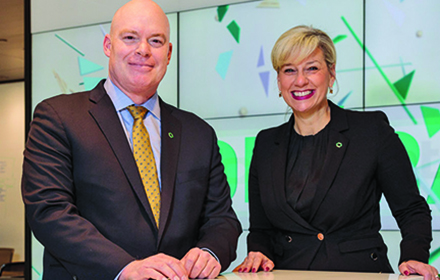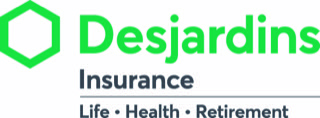DAVID CHARBONNEAU
Senior Vice-President, Group Retirement Savings
JOSÉE DIXON
Senior Vice-President, Group and Business Insurance
Plan sponsors’ and members’ expectations are evolving, and the services that plan providers are offering are changing too, say Desjardins Insurance’s David Charbonneau, senior vice-president, group retirement savings, and Josée Dixon, senior vice-president, group and business insurance. We asked them to share their perspectives on group plans.
How closely linked are personal health and financial wellness?
JD: There is a clear connection between physical, mental and financial health. People can’t be at their best if they’re worried about their finances or debt all the time. It can lead to all kinds of health problems such as stress, anxiety and insomnia. By the same token, people with health problems may worry about the financial repercussions their condition might have for them and their families.
DC: So we work with employers to identify the best prevention strategies and the right savings plans for their employees. Our goal is to accompany them as their financial goals evolve, over the short- and long-term, and to empower them to take charge of their health and wellness so they can live fuller lives now and into their retirement. It’s all about working in the best interests of our clients and their employees.
How does Desjardins encourage health and wellness among its own employees?
JD: It’s a key priority. We offer reimbursements for gym memberships, a comprehensive employee assistance program and wellness platform, a flu vaccination campaign – and we keep raising the bar. An example is the sleep disorder screening and treatment program we helped develop with a start-up company, HALEO. We tested it out in a pilot project with 5,000 of our own employees, and the results were compelling. Thanks to the awarenessraising and educational aspect of the program, two-thirds of all participants surveyed reported an improvement in their sleep, their quality of life and their work performance. And 89% of the employees who received the treatments said their quality of sleep improved. Now it’s being rolled out to all Desjardins employees – and we offer it to our clients
across Canada as well.
Which retirement and savings benefits focused on proactive support are most in demand?
DC: Plan sponsors know we need to provide education that instills confidence and creates healthy habits among members. Through readily accessible multi-channel solutions, such as our Wellness Centre, members can assess their current financial situation and find the resources and encouragement they need to optimize their spending now in support of a comfortable retirement. We’ve developed education sessions and webinars on topics such as debt management, budgeting and investments, and overall wellness. Today, plan members are seeking more tools like online advice, but they may also benefit from one-on-one counselling for their overall financial situation. We’ve developed our solutions with a modular and omnichannel approach giving plan sponsors the flexibility to personalize their offer in a way that makes sense for them.
How can plans better support people caught in the sandwich generation?
JD: Juggling childcare, eldercare and a full-time job takes a toll on employees’ physical, mental and emotional health. Group benefits plans can help by expanding employee assistance programs to include eldercare and childcare referral services, counselling services for caregivers, and even seminars on how to manage the emotional aspects of caregiving. We support plan members with telephone counselling for senior and child related issues. We even offer a service to help parents plan their children’s education. But some key initiatives will have to come from employers, such as compressed work weeks, flexible working hours, compassionate care leave, leaves of absence, and daycare facilities in the workplace. These kinds of programs would really help alleviate some of the pressure these employees are under.
DC: People in the sandwich generation are so busy coping with everyday demands, it’s hard for them to take a step back and get a clear view of their finances. Our online Wellness Centre is a great resource filled with information and resources that cater to their personal situation. We are also able to tailor our messaging through business intelligence to surface the right information or actions that can help them deal with life’s challenges and still stay focused on achieving their goals.
What do plans need to do to accommodate the needs of millennials?
JD: Health spending accounts and wellness accounts are great, and plans just have to be more flexible overall so plan members can pick and choose the benefits that suit them. Equally important, younger employees are used to having everything at their fingertips. We’ve developed apps to give them that same convenience with their group benefits. A travel app that has a multilingual translation service, shows the closest healthcare facility and stores important medical information. Another app tells them if their medication is covered, how much money they’ll get back, how much less they’ll pay for a generic drug, and even which nearby pharmacy has the best price.
DC: The Desjardins approach adapts to different employer cultures and generational perspectives, and to where plan members are in their own savings journey. Millennials have saving needs but retirement may not seem like an immediate priority. Budgeting tools, debt management, unbiased advice, fee transparency, omnichannel experience, socially responsible investments and flexible savings vehicles like TFSAs are concepts that millennials tend to respond well to. The approach can be as simple as tailoring the communication to employees using personalized videos or non-retirement language to get them more comfortable and engaged. Perhaps hosting innovative forums like a “financial happy hour” on- or off-site focused on maximizing the benefits of the plans available to them and learning about debt and savings – using interactive, mobile quizzes and other engagement tools. It’s about being creative and flexible in promoting engagement and, ultimately, lifelong healthy habits.
What innovations will help plans stay healthy and sustainable?
JD: I think virtual care will be in high demand. We’re piloting a virtual care service as we speak. It will give plan members immediate access to a doctor or nurse through chats and videoconferences. And there are some really interesting new technologies coming out. For example, we’ve seen digital glucometers that connect to your phone, record your results and send them directly sent to the doctor for real-time monitoring. Connected devices allow people to take a photo of, for example, their throat or ears, measure their heart rates, and exchange information online with a doctor. On the treatment side, pharmacogenetics and nanotechnology provide more personalized medications and targeted treatments. All these innovations will promote prevention and improve health outcomes.
DC: Plan sponsors are more willing than ever to partner with us to develop innovative solutions to respond to their employees’ unique needs, especially since young employees are increasingly prioritizing benefits over pay. Co-creating with our clients is something we take pride in. We listen to our plan sponsors and, with their guidance and feedback, we fine-tune initiatives to respond to their members’ concerns and needs. As we continue to work more closely with them and share more data, it will give us more opportunities to tailor our solutions. We also customize strategies for employers through a business intelligence service that analyzes plan member behaviour and calibrates an engagement level. By using a proprietary algorithm to aggregate data and taking into account our plan members’ interests, motivations and knowledge, we can conduct a behavioural analysis to define plan member engagement levels. That enables us to build even more targeted communication and education strategies.



